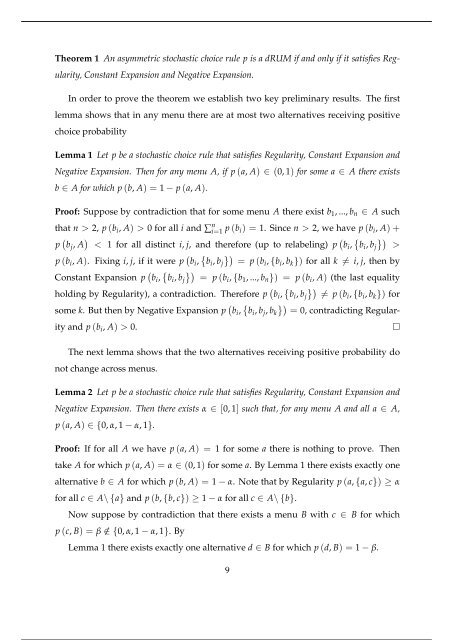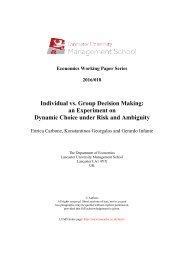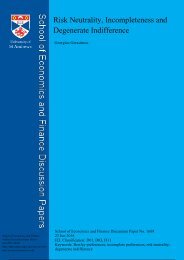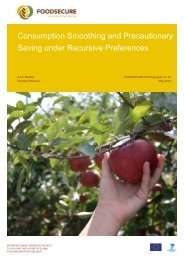Dual Random Utility Maximisation
n?u=RePEc:san:wpecon:1605&r=upt
n?u=RePEc:san:wpecon:1605&r=upt
Create successful ePaper yourself
Turn your PDF publications into a flip-book with our unique Google optimized e-Paper software.
Theorem 1 An asymmetric stochastic choice rule p is a dRUM if and only if it satisfies Regularity,<br />
Constant Expansion and Negative Expansion.<br />
In order to prove the theorem we establish two key preliminary results. The first<br />
lemma shows that in any menu there are at most two alternatives receiving positive<br />
choice probability<br />
Lemma 1 Let p be a stochastic choice rule that satisfies Regularity, Constant Expansion and<br />
Negative Expansion. Then for any menu A, if p (a, A) ∈ (0, 1) for some a ∈ A there exists<br />
b ∈ A for which p (b, A) = 1 − p (a, A).<br />
Proof: Suppose by contradiction that for some menu A there exist b 1 , ..., b n ∈ A such<br />
that n > 2, p (b i , A) > 0 for all i and ∑i=1 n p (b i) = 1. Since n > 2, we have p (b i , A) +<br />
p ( b j , A ) < 1 for all distinct i, j, and therefore (up to relabeling) p ( b i , { })<br />
b i , b j ><br />
p (b i , A). Fixing i, j, if it were p ( b i , { })<br />
b i , b j = p (bi , {b i , b k }) for all k ̸= i, j, then by<br />
Constant Expansion p ( b i , { })<br />
b i , b j = p (bi , {b 1 , ..., b n }) = p (b i , A) (the last equality<br />
holding by Regularity), a contradiction. Therefore p ( b i , { })<br />
b i , b j ̸= p (bi , {b i , b k }) for<br />
some k. But then by Negative Expansion p ( b i , { })<br />
b i , b j , b k = 0, contradicting Regularity<br />
and p (b i , A) > 0.<br />
□<br />
The next lemma shows that the two alternatives receiving positive probability do<br />
not change across menus.<br />
Lemma 2 Let p be a stochastic choice rule that satisfies Regularity, Constant Expansion and<br />
Negative Expansion. Then there exists α ∈ [0, 1] such that, for any menu A and all a ∈ A,<br />
p (a, A) ∈ {0, α, 1 − α, 1}.<br />
Proof: If for all A we have p (a, A) = 1 for some a there is nothing to prove. Then<br />
take A for which p (a, A) = α ∈ (0, 1) for some a. By Lemma 1 there exists exactly one<br />
alternative b ∈ A for which p (b, A) = 1 − α. Note that by Regularity p (a, {a, c}) ≥ α<br />
for all c ∈ A\ {a} and p (b, {b, c}) ≥ 1 − α for all c ∈ A\ {b}.<br />
Now suppose by contradiction that there exists a menu B with c ∈ B for which<br />
p (c, B) = β /∈ {0, α, 1 − α, 1}. By<br />
Lemma 1 there exists exactly one alternative d ∈ B for which p (d, B) = 1 − β.<br />
9






